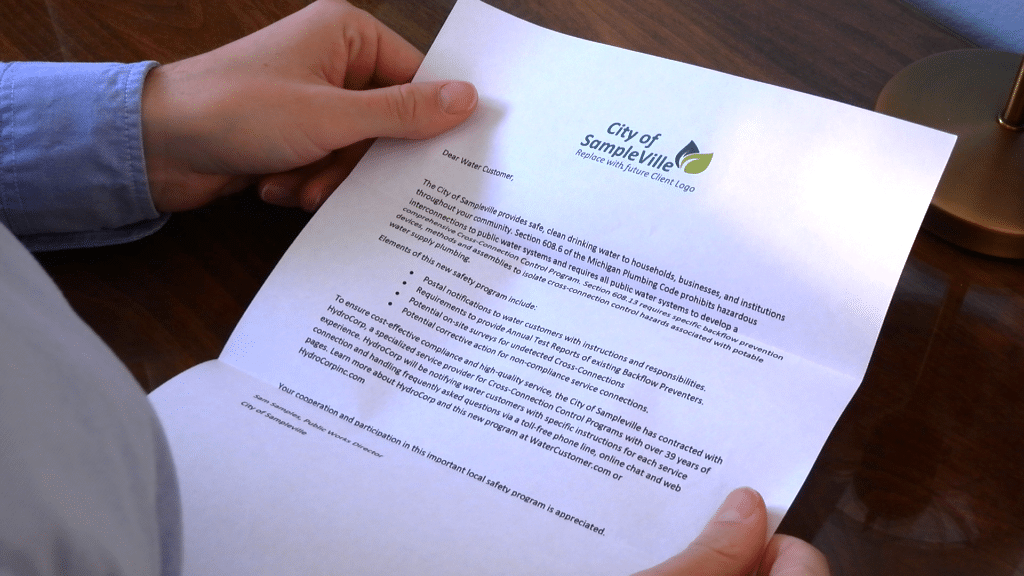Takeaways
- Convincing water customers to follow through on corrective actions is one of the most common challenges faced by water utilities.
- Four escalating steps for encouraging water customer participation are: initial notice and immediate corrective action, engaging and educating the customer, issuing a final notice, and, as a last resort, shutting off the water supply.
- Clear communication, educational outreach, and firm but fair enforcement are key components of a successful compliance strategy that turns water customers into collaborators.
Ensuring the safety of the public water supply is a critical responsibility for water utilities, particularly when it comes to managing contamination risks. While adopting and implementing a robust and comprehensive cross-connection control program to address the issues of backflow events that could compromise water quality, achieving regulatory compliance in this area often involves a strategic approach.
The end user, or water customer, will be the one who will actually complete any corrective action requirements needed to bring their property into compliance. Convincing water customers to follow through on corrective actions is one of the most common challenges faced by water utilities. This blog post will explore the four escalating steps for encouraging water customer participation: initial notice and immediate corrective action, engaging and educating the customer, issuing a final notice, and, as a last resort, shutting off the water supply.

10 Gaps in Cross-Connection Control Programs & How to Fill Them
1. Initial Notice & Immediate Compliance
The first path to achieving compliance occurs with no further effort than the issuance of a notice denoting a corrective action for a cross-connection issue. This occurs when the utility sends out the initial corrective action notice to the water customer, detailing the required steps to rectify the issue and the water customer complies within the required timeframe. This straightforward and prompt response in addressing potential hazards means that the water utility needs no further action to convince the water customer to take corrective action and that the potential hazard is ready for a follow-up inspection to verify it has been brought into compliance.
- Clear Communication: The initial notice should be clear and concise, explaining the nature of the problem, the potential risks, and the specific actions required to achieve compliance.
- Compliance Deadline: A reasonable deadline for compliance should be set, giving the customer ample time to make the necessary corrections.
- Support Availability: Offering resources such as contact information for assistance or detailed guidelines can help ensure that customers understand and can easily follow the required steps.
By clearly describing the hazard, defining the timeframe, and offering water customer support, water utilities can quickly mitigate risks without extensive customer engagement. However, this method relies heavily on the customer’s willingness and ability to comply with the initial notice – which brings us to the next step.

2. Pushback, Engagement, Education
In scenarios where customers push back or fail to respond to the initial corrective action notice, a more engaging approach may be necessary. This involves some convincing by either utility inspectors or customer service representatives (CSRs) to explain the importance of the program and the potential contamination risks associated with non-compliance.
- Personalized Communication: Direct phone calls or emails can be more effective than written notices. These interactions provide an opportunity to address customer concerns and clarify any misunderstandings.
- Educational Outreach: Providing educational materials that explain how cross-connections can lead to contamination events can help customers understand the gravity of the situation.
- Second Notice: If initial efforts are unsuccessful, a second notice should be sent, reiterating the importance of compliance and outlining the next steps. This notice should stress the potential health risks and legal obligations.
By adopting a more personalized and educational approach, utilities can foster a cooperative relationship with their customers, making compliance more likely.

3. Final Notice Before Enforcement
However, when customers continue to ignore or refuse to comply despite prior notices and engagement efforts, issuing a final notice becomes necessary. This notice serves as a powerful statement, emphasizing the utility’s authority and the serious consequences of non-compliance.
Legal Rights Explanation: The final notice should clearly state the utility’s legal rights, including the authority to shut off the water supply if compliance is not achieved. It is crucial to frame this not as a threat, but as a factual explanation of the utility’s regulatory responsibilities.
- Urgency and Finality: This notice should convey a sense of urgency and finality, making it clear that further delays will not be tolerated.
- Last Opportunity: Offering one last opportunity for the customer to comply before any further actions are taken can show that the utility is reasonable but firm in its requirements.
The final notice is a critical step in the compliance process, as it underscores the seriousness of the issue and the potential consequences for the customer. This is typically that final step that gets water customers who are still holding out to bring their building into compliance with the cross-connection control program. But, in some very rare cases, more action may be required.

4. Shut Off Water Notice with Date
Shutting off the water supply is the most extreme measure and should only be used in the most drawn-out cases of non-compliance. This action underscores the utility’s commitment to public safety but must be handled with caution and due process.
- Documentation: Before shutting off the water, ensure all previous communications and notices are thoroughly documented to provide a clear record of the efforts made to achieve compliance.
- Due Process: Follow all legal and regulatory procedures to ensure the action is justified and legally sound. This may involve additional review to confirm the necessity of shutting off the water.
- Notification: Provide the customer with a final notification before shutting off the water, specifying the date and time of the disconnection. This gives the customer one last chance to comply.
- Follow-Up Support: After the water is shut off, remain available to assist the customer in achieving compliance and restoring their water service as quickly as possible.
Shutting off water is a last resort and highlights the utility’s unwavering commitment to protecting public health. While it may be rare, this measure ensures that the distribution system is kept safe after all other avenues for voluntary compliance have been exhausted.
Next Steps
Achieving regulatory compliance with cross-connection control programs requires a strategic and graduated approach. By starting with corrective action requirement notices and escalating to more intensive engagement in a methodic and reasonable way, utilities can effectively manage cross-connection risks while maintaining positive customer relations. Clear communication, educational outreach, and firm but fair enforcement are key components of a successful compliance strategy that turns water customers into collaborators in the mission to keep the drinking water safe from the hazards of backflow contamination.


